Perhaps NZ’s most famous Packrafting journey
The Hollyford-Pyke loop is probably NZ’s most classic packrafting trip. Seemingly defying gravity, the Hollyford’s waters take you to the coast, then after only crossing an 80m high saddle, the Pyke guides you most of the way back towards where you began. Following deep valleys, across 3 major lakes and wild west-coastlines, the soaring peaks, gorgeous beaches, and plentiful wildlife compete for your attention during this superlative 5-6 day journey.
This is a word-class journey; and everyone who has had the privilege will agree.
Originally a tough 10-day tramp, these days the hut books are dominated by Packrafting groups. Although highly popular, this corner of Fiordland is a wild and truly remote place. Apart from at the huts, you’ll be out there all alone….
But first a couple of warnings!
It is perhaps NZ’s most under-estimated Packrafting journey.
The popularity and lower river technical grades mean that many people who are newer to packrafting are attempting this trip.
Though the rivers only grade I to II on the international river grading scale, that masks the fact that there are extremely high-consequence hazards that require active risk management.
This is not a trip for complete river beginners. Please take the time to build a foundation of paddle and river knowledge on other rivers, and ideally, take a packrafting safety course.
Most groups have a fantastic trip, but there are a growing number of stories of ‘near-miss’ incidents or accidents involving groups who aren’t giving the hazards the respect needed.
What follows isn’t meant to scare you, or put you off the trip. We (the packrafting community) are trying to ensure people travel this wild part of Fiordland with the skills, gear, and respect needed to come home to tell everyone about it…
Hot tip: if you’ve only got a short time and want to tick this off your bucket-list, the smartest move is to go with a guided group.
The rivers are FULL of trees, forming potentially lethal strainers
Because of the regular and sometimes biblical-scale flooding, there are (literally) hundreds of mature trees scattered through the river. Each of these forms a strainer. A strainer is where the water can pass around and/or through the branches, but anything solid (like you) is ‘strained’ and trapped on the upstream side.
Once trapped in a strainer, rescue is extremely difficult, even for a highly qualified rescue team, and out in the wilderness, your chances of surviving/being rescued are very, very small.
Strainers are a major hazard on any river, and this circuit has hundreds of them.
How do you manage this risk?
You must constantly be aware of what is coming downstream. The views are so magnificent, that this is actually a real challenge! Checking downriver constantly is your priority, so you know where the trees are. Your aim is to have enough time to make a plan to navigate the maze, and enough time to propel your packraft across the currents to successfully follow your chosen route.
You need to understand how the currents will influence your path on the river and the techniques (like ferry gliding and eddy hopping) to maneuver through the maze. You need to know how much time it will take to move your boat that far across the river, and how that compares to the time you’ve got before the strainer reaches you. Plus you’ll need to know how much power is needed to make that move.
You’ll need discipline to start avoiding the hazards early. Eddy out and scout sections where you aren’t 100% certain you have a safe route through.
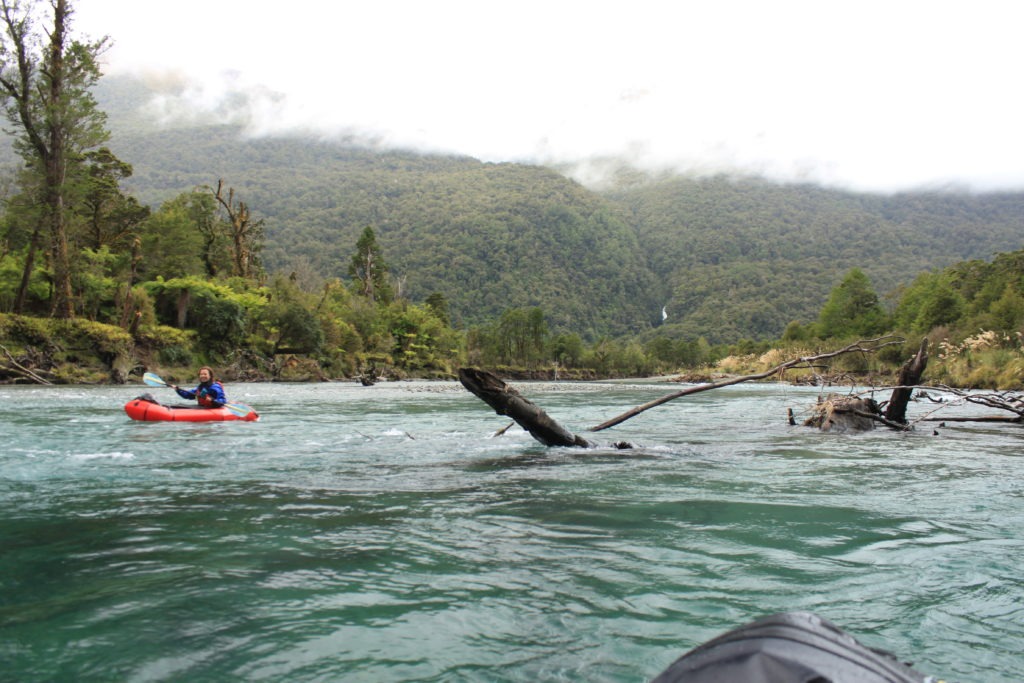
Images (c) Dan Clearwater unless otherwise credited
Maybe an analogy would help. It’s a little like driving a car, stuck in 2nd gear with the accelerator partly glued down, through a well-marked a minefield. Easy enough if you know the car, stay alert and drive well, but failure to do any of those things equals KA – BOOM!
Wind on big lakes: waves, capsizes, packrafts blown away…
There are 3 significant lakes to cross on this route, all of which are exposed to the prevailing north-west winds, as well as daily sea breezes.
If you are taking the ‘direct’ line across the lake, it’s easy to be half a kilometer (or more) away from shore. Winds can come up quickly, creating surprisingly large waves. Waves combined with wind gusts can easily cause you to flip.
Because packrafts are light compared to their volume, the wind catches them well, and they can easily be blown away, faster than you can swim… And there you are, bobbing 500m from shore, in choppy water and fierce winds, a potentially life-threatening situation.
This exact scenario has already happened on this journey, resulting in a mid-lake helicopter rescue. The survivor activated a PLB, and was lucky that the weather was good enough for the helicopter to fly. If the cloud had been lower, they may not have survived….
How do you manage this risk?
The good news is there are lots of ways to avoid this scenario and manage the risk
- Pick your weather. If it is forecast to be windy, stay off the lake, or follow the shoreline.
- Adapt your line to the conditions. Consider following the shoreline, at a distance you could swim to reach land. That line is less efficient but gives you more margin in rougher conditions.
- Wear a dry suit. Even on a warm day, the lakes are cold. A dry suit massively increases your survival time if you were to lose your boat. In water below 12C, you have 30-60minutes before total exhaustion and 1-3hrs until death. See the Maritime NZ advice on survival when floating in water.
- Have your PLB secured and accessible on your PFD. So if the worst happens, you could activate an emergency distress call whilst bobbing in the water.(like our survivor in the example above did!) Plus stash some basic survival aids, such as matches, survival blankets, and spare snacks, so you can stay alive until rescue if you reach the shore but have lost your boat…
- Be smart if your pack is on your bow. For a lake crossing, only secure the pack at two points, rather than four. If your boat flips, the pack can then act as a sea-anchor, slowing the rate of drift of your boat.
- Stay together. So if someone does flip, you can buddy rescue. Long crossings are tiring, so some people might struggle to pull themselves back into their boat. Plus, if it gets really scary, you can raft together to be more stable whilst re-evaluating your options.
But most importantly, leash yourself to your packraft.
In rivers, leashes are a big no-no, as they can cause an entanglement hazard, which can lead to drowning. But if there is any wind on a lake, the overall risk of losing a boat is higher than the overall risk of becoming entangled if you flipped, so leashes are recommended. A leash should be long enough that you can swim to the side tube of your boat to self-rescue. It should be short enough to minimise the likelihood of entanglement during the flip.
Make a leash, practice flipping and self-rescue in a pool or lake near your home, and adjust it as necessary.
The storms here are HUGE…
In February 2020 an extreme weather event hit the region, with severe slips, damaging huts, destroying all the cabins at Gunns Camp and shifting the mouth of the Hollyford 2.5 kilometers from where it used to be.
The page has been updated after the storm, but don’t be surprised when the river doesn’t follow the path it used to on the topographical map.. If you have any futher updates, contact dan@packraftingtrips.nz
Even ‘normal’ storms here are frequent and dump serious amounts of rain, which can cause rivers to flood and become a brown, turbulent mess, which can propel packrafts at alarming speed through the strainer mine-field.
How do you manage this risk?
Firstly, pick your weather and give yourself time… The views of the mountain peaks are a real trip-highlight, so it really is worth waiting for decent weather for this trip. Book yourself a week off work, and pick the best forecast within that window. Plus, if you hit bad weather, you’ll have time to wait it out.
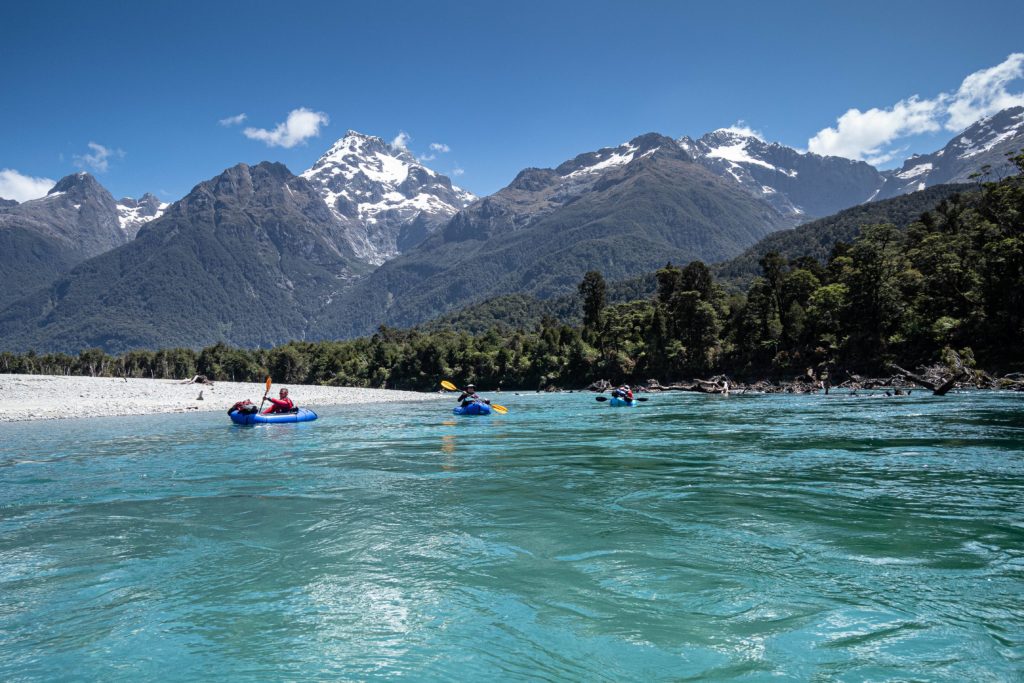
Next, take spare food in case you make the (wise) decision to remain in a hut for the storm to pass and the rivers to drop.
Take a tent, so you have the option to shelter where you are if you have to. (Plus the trip is so popular nowadays, that a hut-bunk is no longer guaranteed!)
Suggested itinerary
This description breaks the trip down into recommended days, though you could easily spend more time if you wanted to. As mentioned above, having a day or two up your sleeve for adverse weather is a good option. Some sections (such as Lake McKerrow) required good conditions to be able to paddle. The bad weather walking alternative to paddling would be much slower and more arduous. The same goes for the Pyke Valley.
The times below are a rough guide: you might be faster or slower depending on conditions, fitness and decision making.
| Day | Route | Time |
| 1 | Hollyford road end to McKerrow Island Hut | 6.5hrs |
| 2 | Onwards to Martin’s Bay Hut via Lake McKerrow (weather crux is the lake paddle) | 5-10hrs |
| 3 | Martin’s Bay Hut to Big Bay Hut | 4-5hrs |
| 4 | Big Bay hut to Olivine Hut | 6-7hrs |
| 5 | Olivine Hut to Alabster Hut | 4hrs |
| 6 | Alabaster Hut to Road end | 5.5hrs |
View full screen on www.Topomap.co.nz
Plan and prepare
Huts
Check out the Hollyford Valley area page on the DOC website for more information about huts, hut fees, Hollyford Track notes, Pyke-Big Bay track notes and other short walks in the area. The web pages about the huts have GPS coordinates. Because some huts are less visible from the river, it is worth having the hut waypoints if you are bringing a some sort of GPS capability.
Wind and tides
These influence travel on the lake, estuary and coastal parts of the route, so it’s worth doing your homework on these before you go. The closest tide table location is Jackson’s Bay (northeast of here) and you should definitely have an offline copy to bring on your trip.
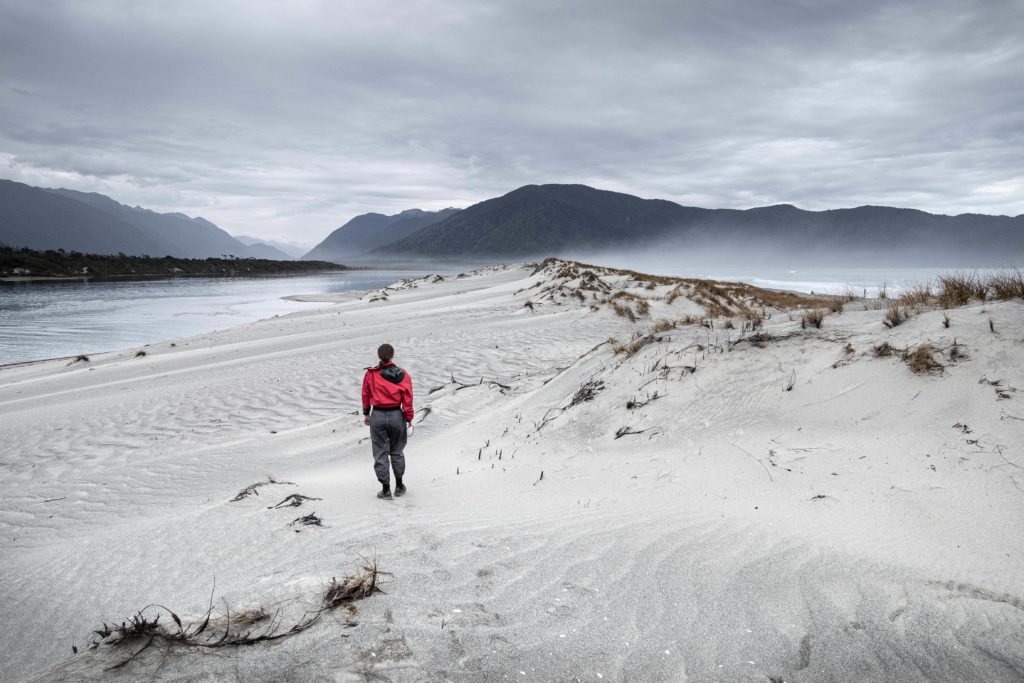
Food
Since you are floating for the first part of the trip, it’s well worth bringing gourmet food and drink. This has the effect of making friends at huts, who then seem to want to take up packrafting….
Gear suggestions
It’s probably best to think of the paddling as ‘sea kayaking’ rather than white water when it comes to paddle gear selection. We didn’t take helmets and didn’t feel they would have been necessary. Barely saw a handful of boulders in the rivers the whole trip. A throw bag is well worth having, as the number of trees in the river means that some way attempting a rescue for someone on a tree is well worth it. The river is quite wide in places 30+ meters so consider the weight vs the range of your throw bag. A throwbag is useless without the knowledge of how to use it. Do a river safety course so you know what to do in an emergency.
If there’s any hint of anything but baking hot, settled weather in the forecast, then good cold water protection is important. The water is pretty cold, and out on those big lakes, you can feel quite exposed. Any decent wind on the lakes can make for serious chop, which is probably more likely to tip you out than the rapids are. On hot days, the valley’s experience a sea breeze, which can whip up those waves. We wore drysuits through drizzle, torrential rain and windy hot days and felt comfy the whole time.
A GPS is probably a good thing to have for the section between Big bay Hut and the Pyke River. Here, the track meanders a lot and is poorly formed and sparsely marked. You’re in the forest the whole time, so it’s tricky to orientate yourself. Losing the track wouldn’t be the end of the world, but it would be very time consuming trying to bash through to the east. Better would be re-tracing your steps via GPS and then re-intercepting the track.
If you like fishing, get yourself a freshwater fishing licence and take a collapsible spin fishing setup. The rivers are quite big, deep and somewhat featureless from a fishing point of view, so spin gear covers lots of water when blind fishing. You can also troll from your packraft as you paddle the lakes. Contouring the drop off might take you a little longer, but also might help shelter you from the wind if its there..
Martins Bay Hut and Big Bay might offer some sea fishing opportunities, but probably not ones that you can effectively do with anything less than a decent surfcasting rod. The ocean is generally very rough and the shore quite rocky (not in a good way for fishing). We did find it easy to get a feed of muscles at dead low tide from the rocks around Big Bay.
Don’t forget your insect head net and some bug repellant. Sitting outside without these is an exercise in tolerance that won’t last long without those bits of kit.
There was usually plenty of side streams along the way, so a small Nalgene as a mug and water bottle works well and saves carrying unnecessary water weight in your pack.
Bring a tent. Although there are lots of huts along the route, these days they are often quite busy with other packrafters. In the Hollyford, Jetboating groups are relatively common at the huts. Plus a tent gives you more options in the event of bad weather.
Day 1: Hollyford Road to McKerrow Island Hut 6.5hrs
- 2hrs Hollyford road end to Hidden Falls Hut
- 15mins Hidden Falls to Little Homer Rapids
- 10-20min Little Homer portage
- 4hrs Portage to McKerrow Island Hut
Make sure you stock up on food and fuel at Te Anau. That’s the last chance before you drive another 2 more hours to the Hollyford Rd end.
The huge floods of 2020 destroyed Gunn’s Camp (about 8km before the road end) which no longer provides any supplies or accommodation.
Hot tip for the put on
Before 2020, you’d put on at the end of the road, but after the floods the main channel moved quite a distance away! There’s two options:
- Blow up your boats at the carpark, then at the Humboldt Creek swingbridge, scramble down to the dry riverbed and walk 100 or so meters to the west to find the river. Put on in a big eddy, and just be wary that this channel is fairly narrow and there are usually trees in the river to avoid.
- Walk for about 1.2km down the old right-hand channel (which is gravel with little sections of landlocked ‘river’) until you meet the main channel.
Whilst the upper Hollyford includes some very hard kayaking runs, below the road end the river is a very different proposition. Its reasonably big volume class I, with the occasional little wave train that might just make class II, virtually all of which can be easily portaged. There are plenty of long slow sections, where you can paddle along, or just lay back and enjoy the incredible views of major summits of the Darran Mountains, such as Madeline and Tutoko.
As mentioned before, the greatest hazard of the middle Hollyford is logs. The frequent floods in the area have sprawled the river with huge numbers of trees. Most rapids have a few in them, and some have enough that you almost need to scout the line through the wood. Indeed, a few times we needed to catch an eddy behind one tree in order to make the move to get through the gap below. So even though it’s basically class I water, you need decent class II skills to be safe.
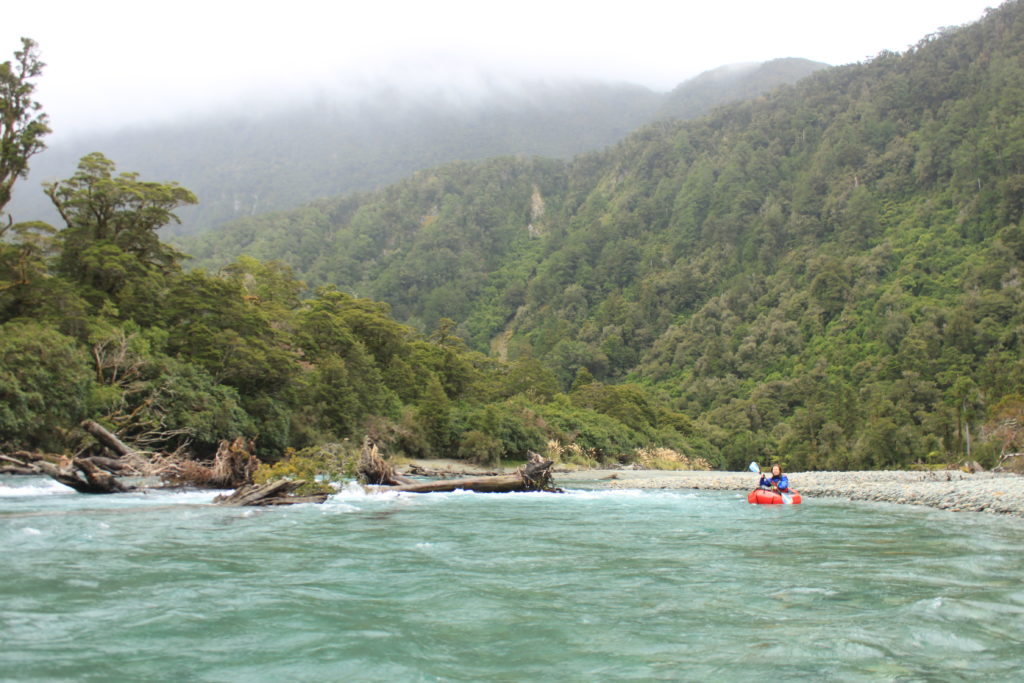
It’s about 2hrs from the road end to Hidden Falls Hut (12 Bunks, serviced hut). The hut isn’t visible from the river, but if you take out immediately after the confluence of Hidden Falls creek, and scramble up the scrubby bank to the flats to the east, you’ll be able to see it then. There are a few trails through the grassy flats to the hut. The hut looks large, but about half of the volume is wardens quarters!

The Little Homer rapids (class III+) are just after glacier creek enters on the true left. They are very easy to spot: huge boulders start to appear on the horizon and you can easily hear the rapid.
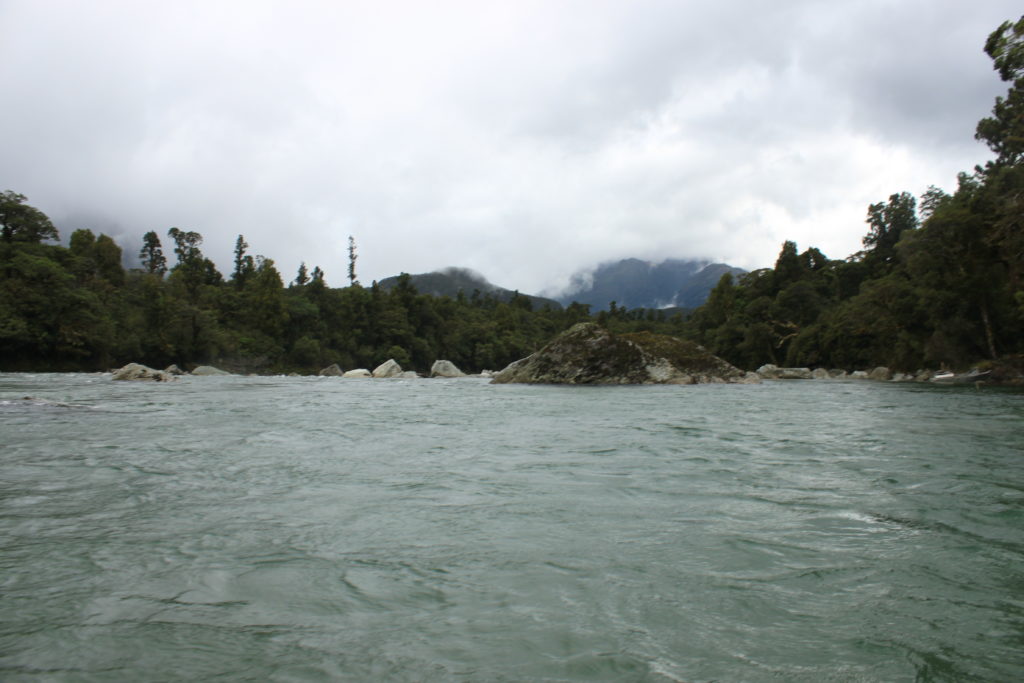
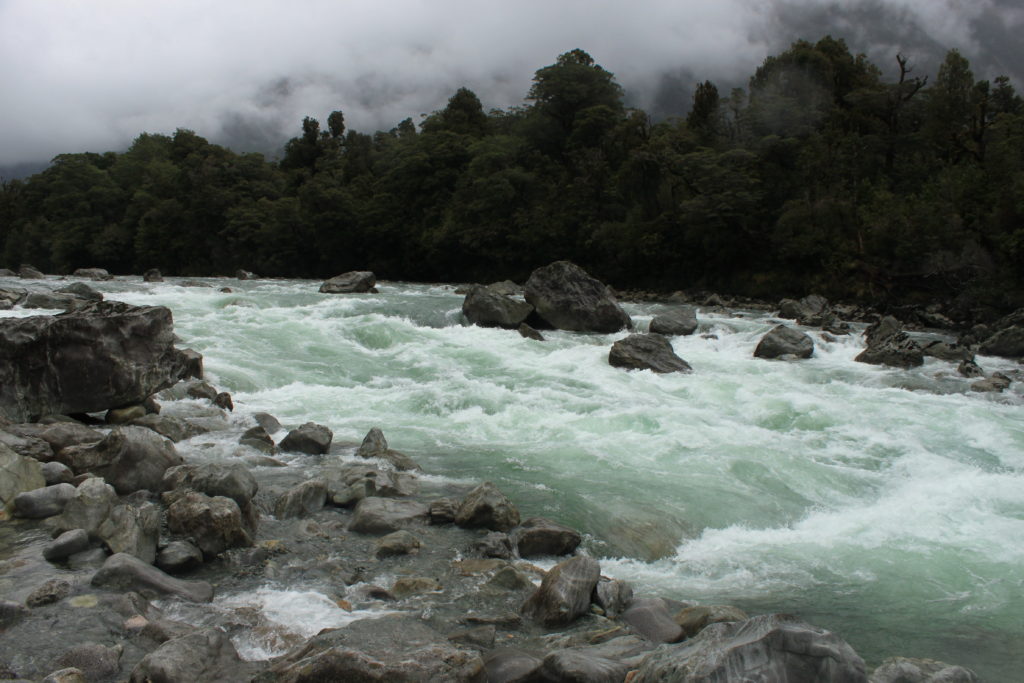
The jet boat portage is on the true right, immediately above the boulders. If you’re paddling near the true right bank, it is easy to find. Jet boaters winch their boats through the forest, through a muddy, uneven ‘track’. Quite odd to be passing a powerboat in the forest…

For packrafters, it’ll take you 10-20mins to use the portage track. It’s muddy and slippery and you’ll curse the extra wine and cheese (just remember the rest of the first part of the trip is all downhill!). It’s not possible to portage the whole Little Homer Rapid on the river bank, so generally packrafters will use the portage track.
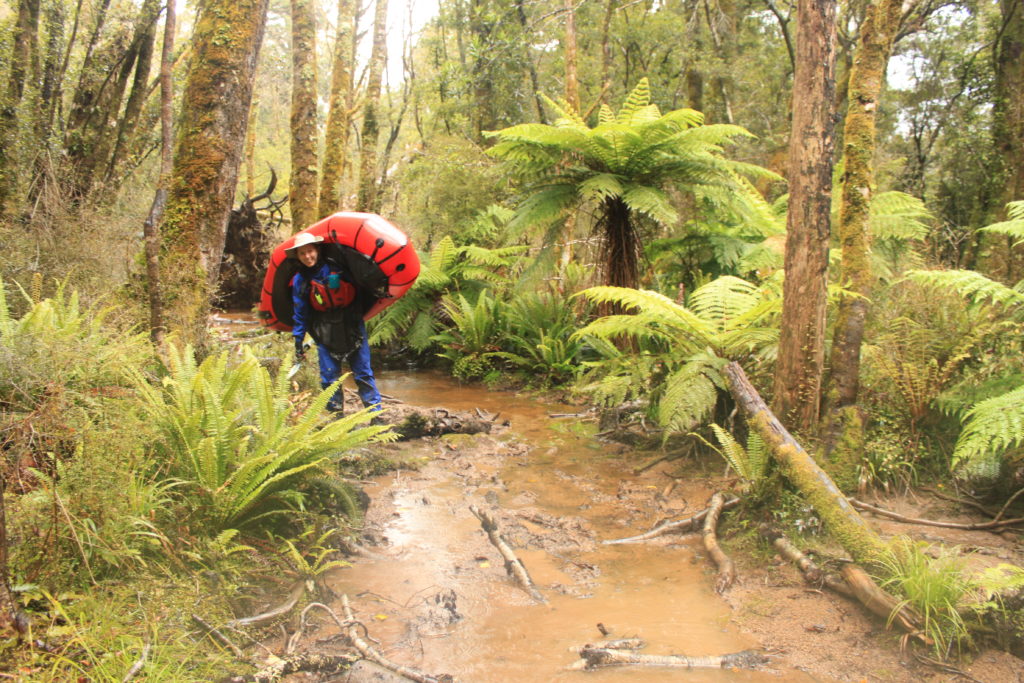
Apart from one notable class II wave train just above McKerrow Island, the rest of the middle Hollyford is the same as the first section. It’s about 4 hrs from Little Homer Rapid to McKerrow Island Hut.
McKerrow Island Hut (12 bunks, standard, fireplace, mattresses) is just inside the bush edge as shown on the map. There are little informal tracks from the true right of the river, directly to the hut, but they are a little harder to find from the river (easy from the hut). Cutting the corner of the sandspit and walking south on the beach, you’ll soon discover a big orange triangle which indicates the short path to the hut.
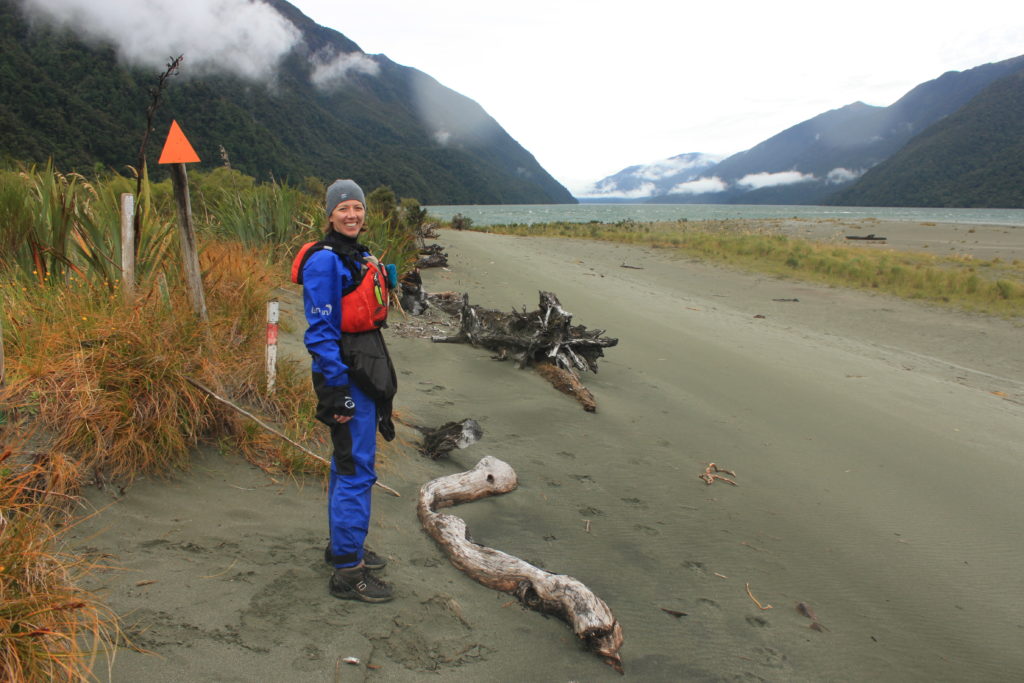
This was a great place to stay, with lots of character… Especially when you consider the hut was flooded to the roof level in the February 2020 floods, and the occupants had to kick holes in the cladding to let the water through the hut to stop it from being swept away….

Day 2: McKerrow Island Hut to Martin’s Bay Hut 5-10hrs
Do your homework on the tides, winds and get an early start! It is well worth factoring in a spare day if you had to wait out the weather, or plan to break the section into chunks using Hokuri or Demon Trail Huts.
This day is the technical and physical crux of the trip. The wind is the primary factor affecting this section, followed closely by the tides in the lower Hollyford estuary. If there’s any strong wind or whitecaps on the lake, don’t even bother. It’s better to wait for a day or start the 10-12hr walk to Martins Bay.
Unless there is a dominating wind forecast, generally an up-valley sea breeze will develop over the course of the day. The standard tactic is to wake up very early (like a few hours before sunrise) so that you are on the water at first light (sunrise minus about an hour). This allows you to get as much paddling done before the sea breeze kicks in.
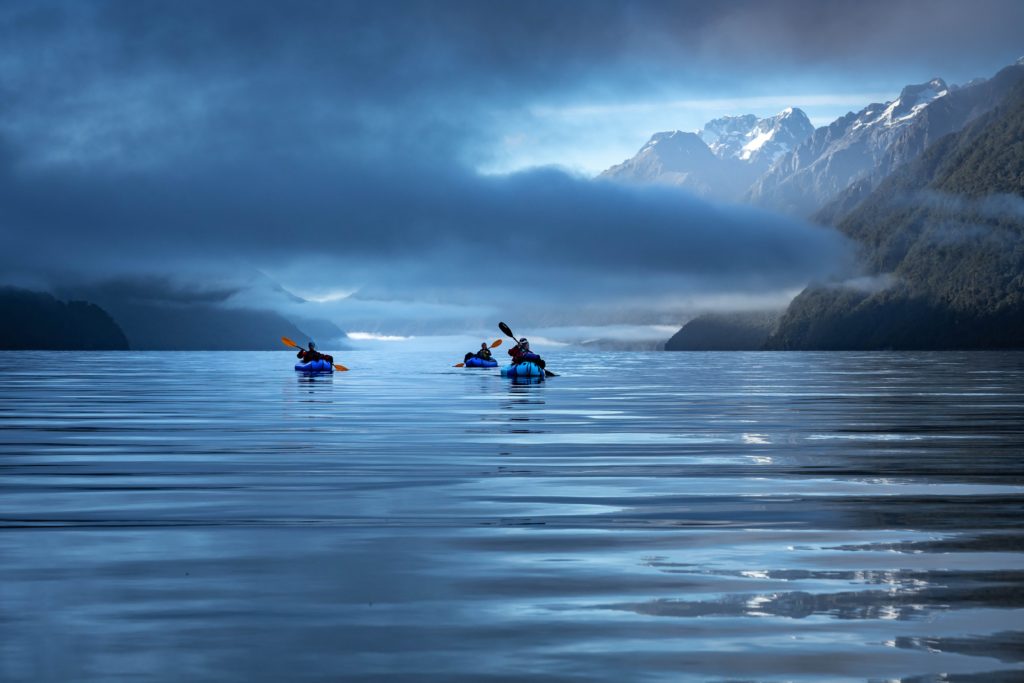
Demon Trail Hut is easy to spot from the lake, as it sits on a bluff about 10m above the lake. It appears that there’s a beach to land at just south of the hut, where you could probably bush bash up to intersect the track, though we didn’t check this.
Hokuri Hut is not visible from the Lake, but if you’re following the map carefully, you should be able to spot the DOC signs on a beach just below the hut. These indicate a short track up to the hut.
Beyond Hokuri Creek, the Hollyford track goes along a gravel beach. By this stage the wind had come up for us, so we got out and walked the shoreline dragging our rafts by our throw bags. Was probably about the same speed, but much less effort and used different muscles!
To paddle the estuary or walk the track….?
At the northern end of Lake McKerrow, there are a few orange triangles where the track heads inland. This is a key decision point. To choose whether to paddle the estuary or walk the track and you need to consider the tides and wind.
An important factor is that since the February 2020 floods, the mouth of the Hollyford has moved 2.5 kilometres from where it’s shown on the map.
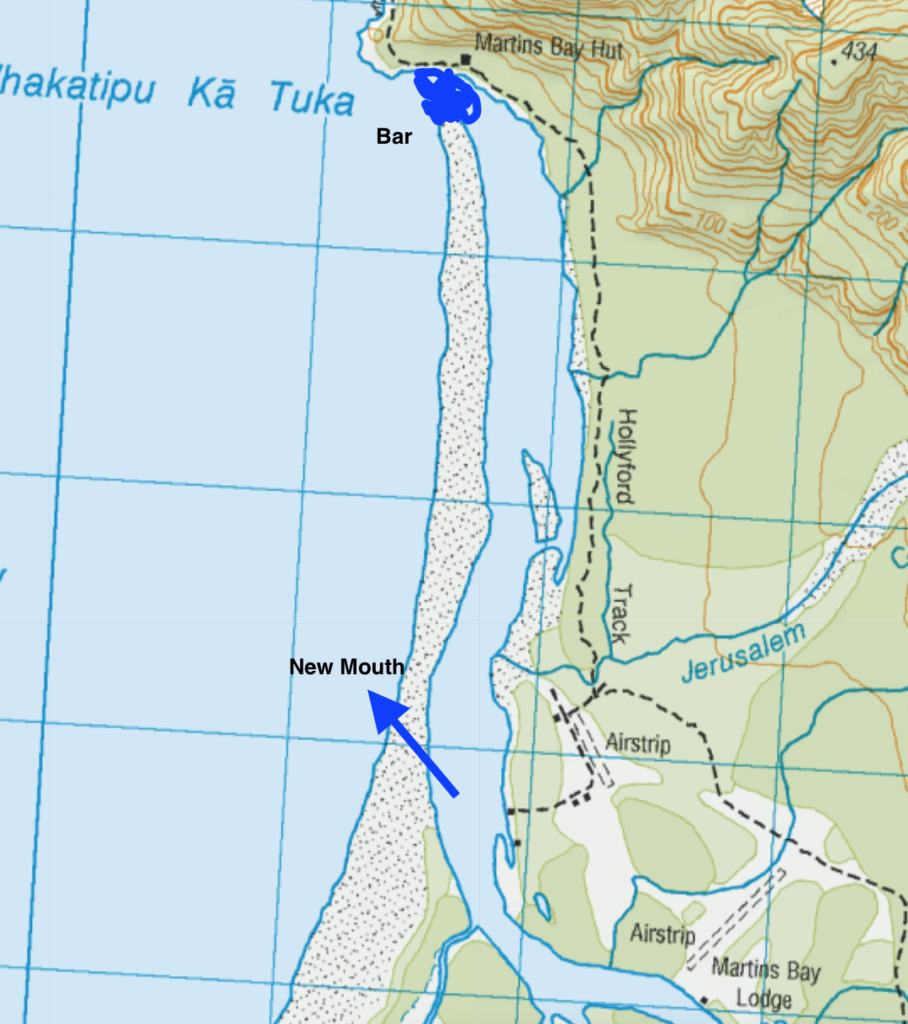
- If there’s a headwind, or the tide is incoming, I’d suggest the track (3-4hrs walk) even though it takes time to transition to walking mode. The tidal surge heads a long way up the estuary, so even if it past high tide, the water might be still heading up the valley.
- If the tide is outgoing, the outflow will make the section between the new mouth and the sand island harder. Packrafters report having to drag boats from the shoreline at times, depending on the outflow and distance from the mouth.
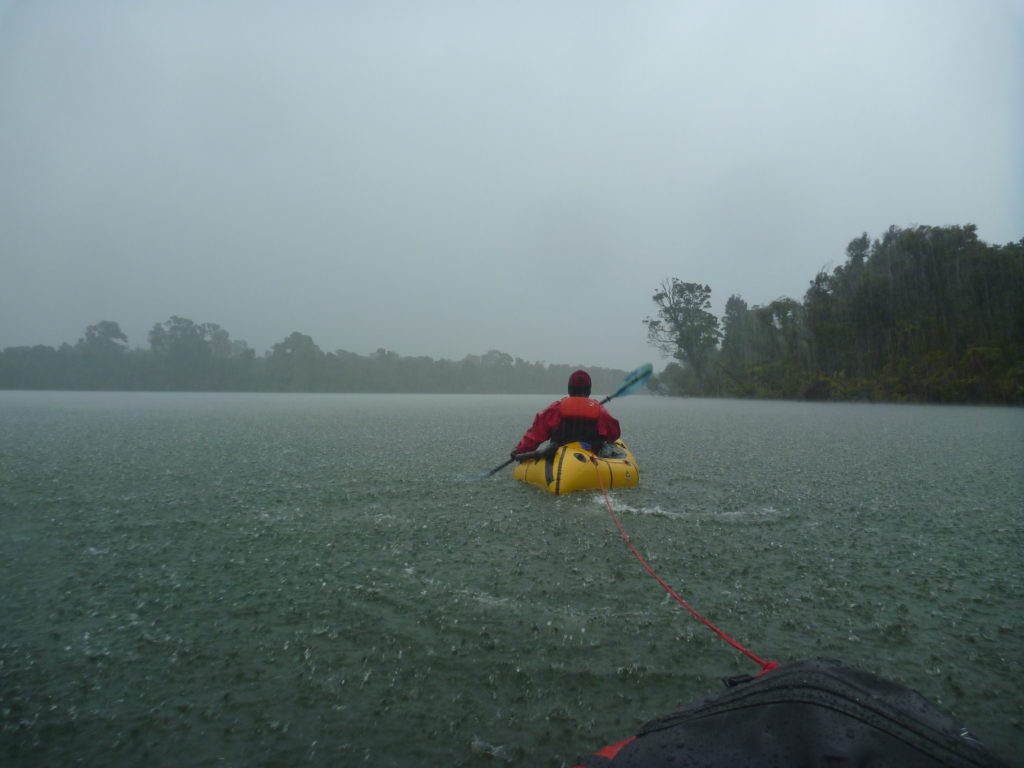
After the sand island, it’s an easy flatwater paddle along the estuary.
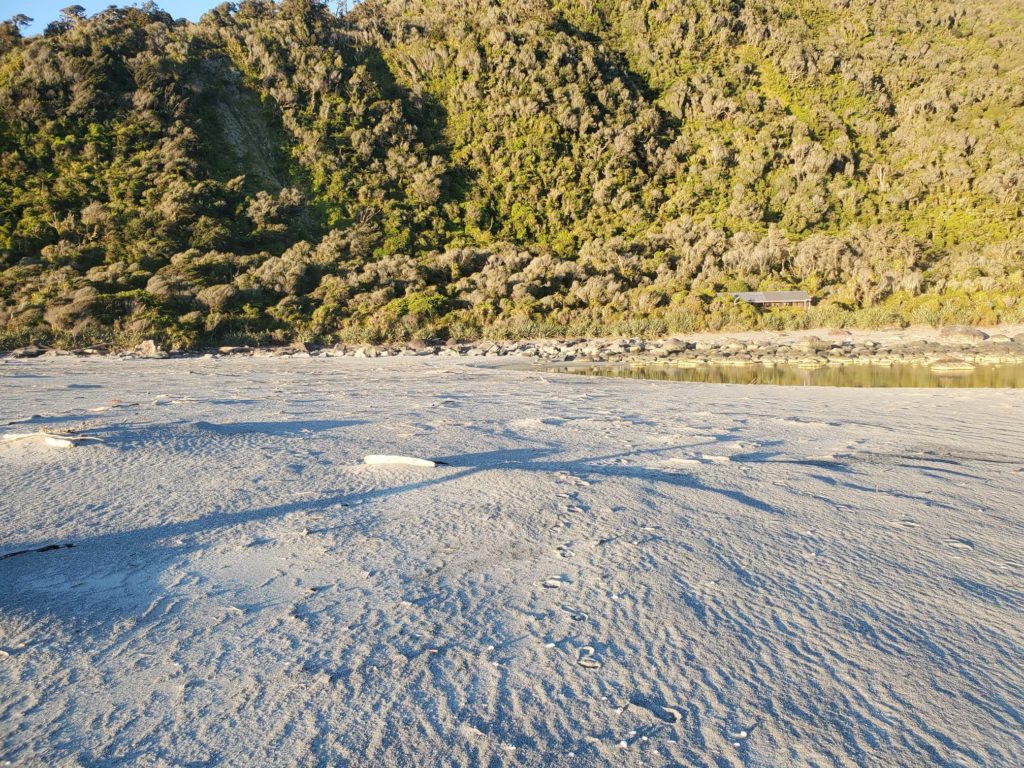
Martin’s Bay Hut (24 bunks, serviced, heating) now has a new beach, which is a great spot to watch the sunset from as you enjoy your fancy (heavy) food and beverage whilst the trampers look on longingly…

Day 3 Martin’s Bay Hut to Big Bay Hut 4-5hrs
The track begins well-formed from Martins Bay Hut to the Long Reef Seal colony. There are plenty of seals around; keep your distance and observe them from afar. In the past, packrafters used to rock hop/go via the beach when the tide was low and the ocean calm. Since the track was re-cut, this is no longer recommended, there has been more than one story of a packrafter getting harassed by a bull seal after nearly landing on one sleeping between the rocks! The track is much faster and gives the seals their space. Please respect the wildlife by using the track.

The track is well-marked and easy to follow to Big Bay. It’s muddy and boggy in places, and crosses a few little streams along the way, with plenty of options for collecting drinking water until Three Mile Beach.
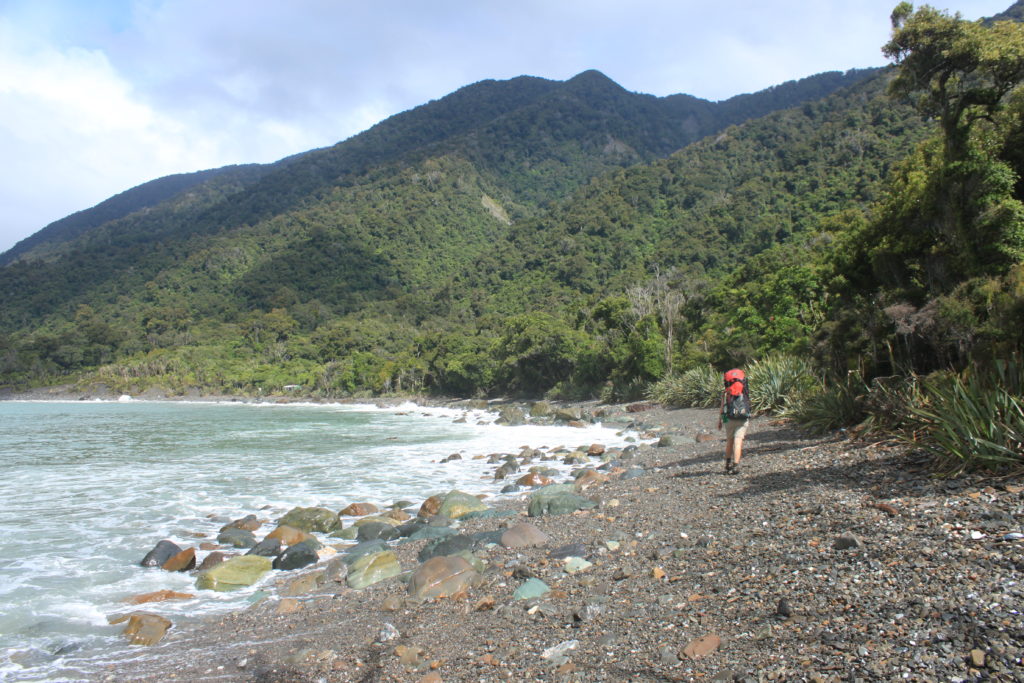
Orange triangles mark the track across penguin rock as marked on the map. East of the private hunter’s houses, there is an old bulldozed track which is much faster travel than the gravel beach.
Both Martins Bay and Big Bay huts have warning signs about the shifting gravels of the McKenzie Creek mouth, which will change between each flood. It could be an ankle-deep quicksand crossing, a deep estuary pool or something else entirely. Enjoy the surprise, and be glad you’ve got a packraft should you need it…
4-5 hours from Martins Bay, you’ll reach Big Bay Hut (9 bunks). It isn’t visible from the beach: you need to be at the high tide mark to spot the DOC sign that shows the trail to the hut.
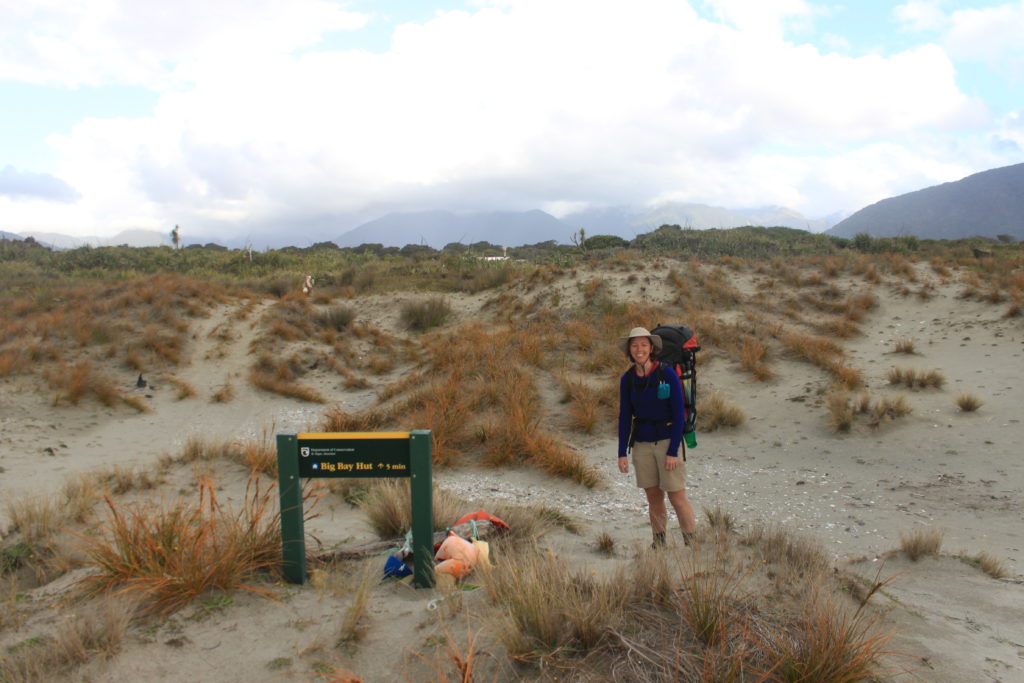
There are lots of private white baiters huts in this area: remember to respect private property.
Big Bay Hut is a great hut, with plenty of character, set back from the beach, but unfortunately without any views.
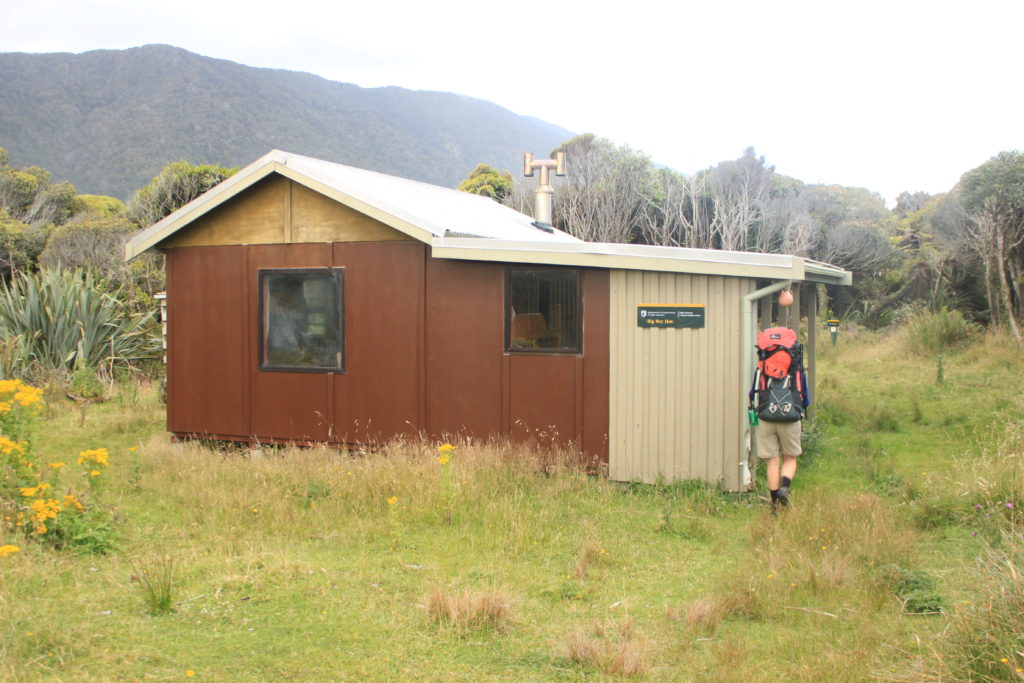
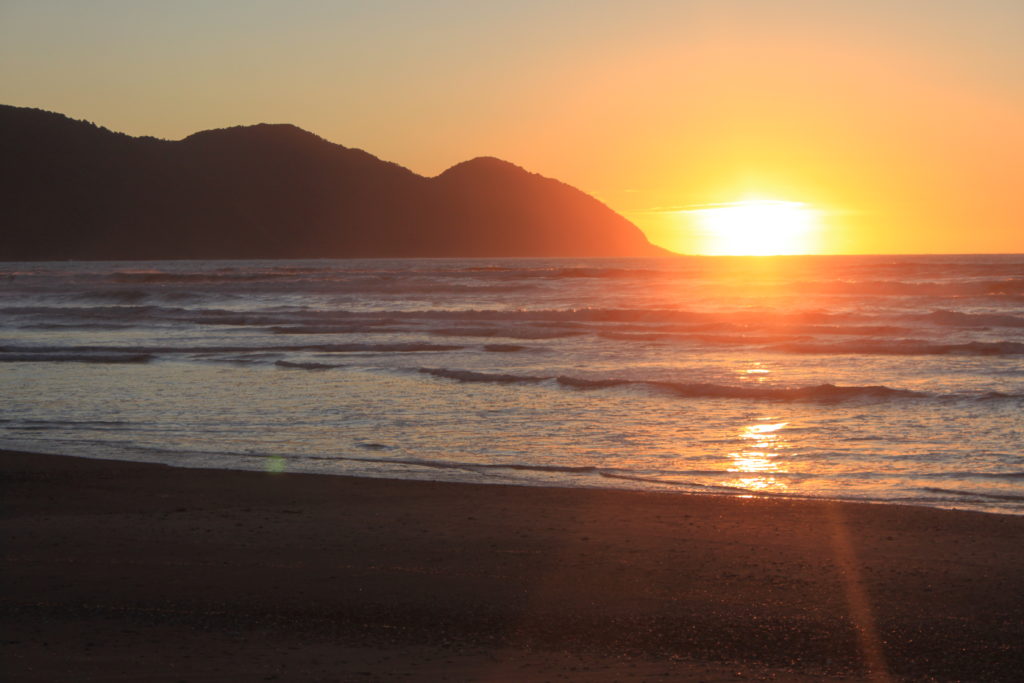
Day 4: Big Bay Hut to Olivine Hut 6-7hrs
- 3hrs from Big Bay Hut to the Pyke.
- 3-4hrs paddling to Olivine Hut.
It’s a reasonably sized day through to Olivine Hut, but if you can time your start to be within an hour or so of low tide then you’ll save yourself some time. To access the start of the Pyke track via the swing bridge takes about 45 muddy mins, but going directly across the river mouth, north of the hut is on via grassy tracks and takes about 15 mins.
The Pyke Track is a quad bike size track, which is pretty easy to follow right up to the Dry Awarua River. There are also plenty of side streams for water in this section.
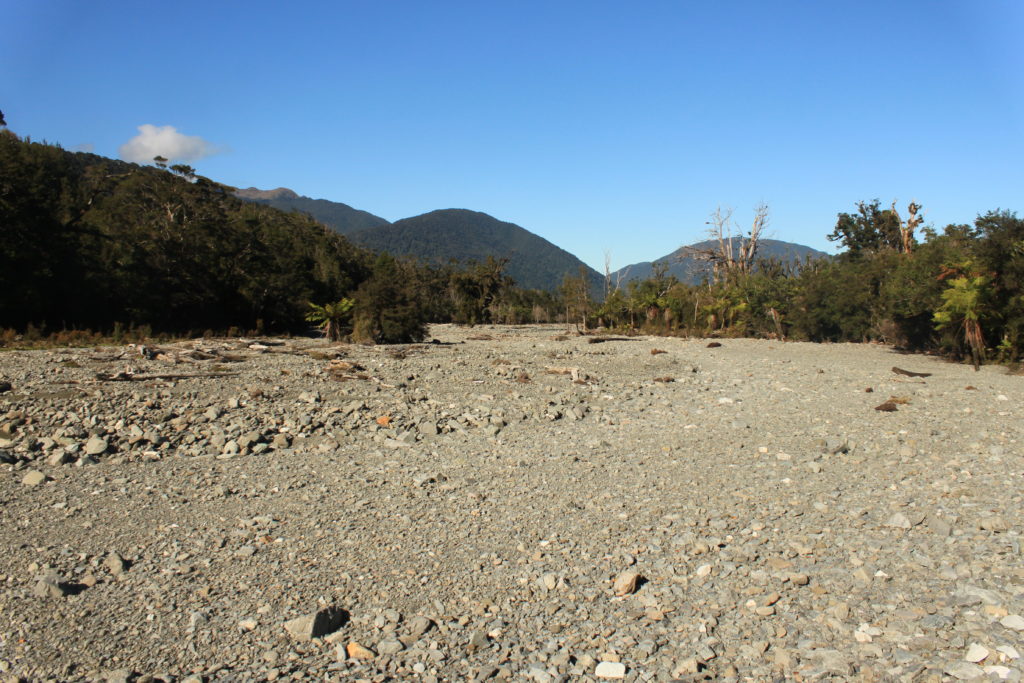
East of the Dry Awarua, the track becomes less well marked, more overgrown and meanders a lot. A GPS would be worth having in this section in case you lose the track. There isn’t any more drinking water till the Pyke. The final part of the track heads down a (usually) dry river bed.

The upper Pyke river is a scenic highlight of the trip. Incredibly deep pools, crystal clear water and few rapids make it a sublime float. There are still plenty of logs to watch out for though.

The gorgeous water clarity ends at Lake Wilmot, which is very silty.
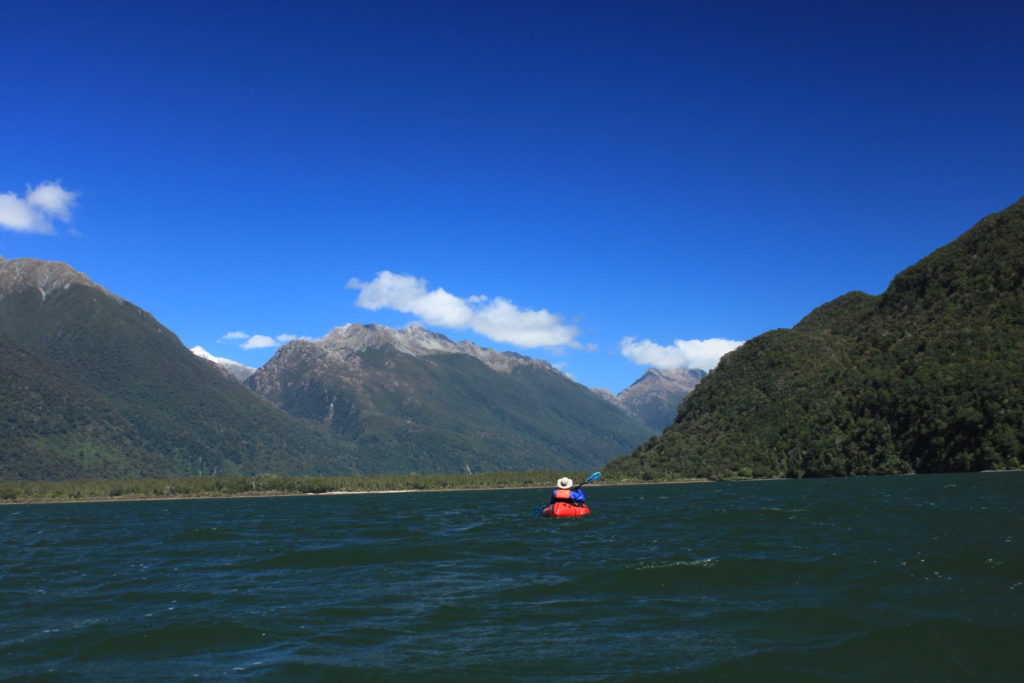
Downstream of Wilmot, there is a section of Didymo infested water, which is very upsetting: please do your bit to check, clean, dry your gear between waterways.
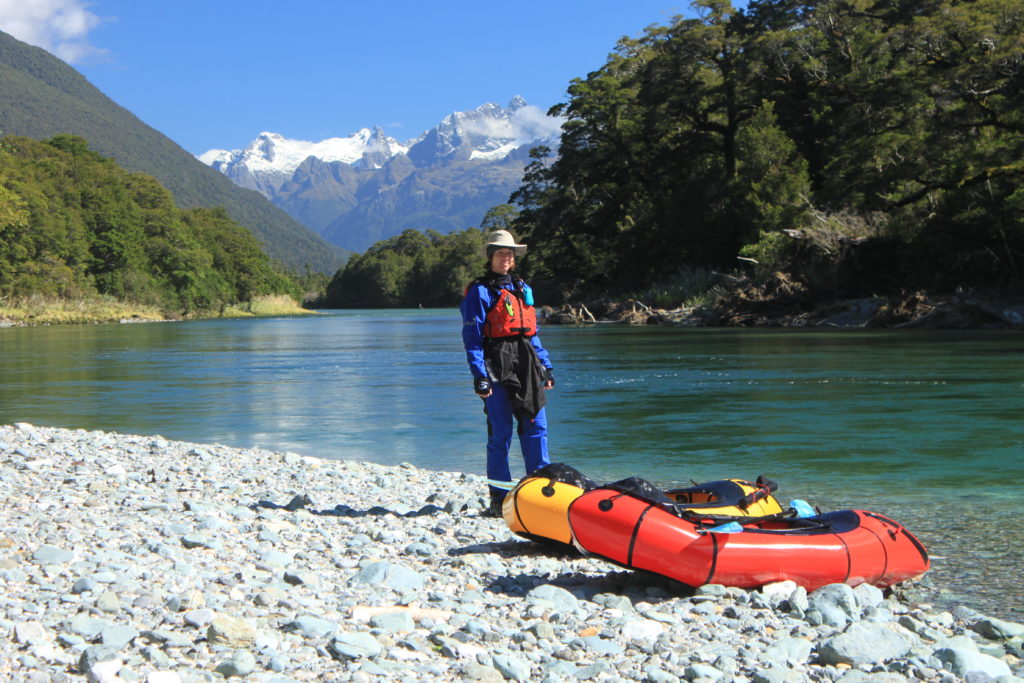
Olivine Hut (6 bunks, standard, mattresses, bunks, stove) is just visible from the river, as is the cableway.
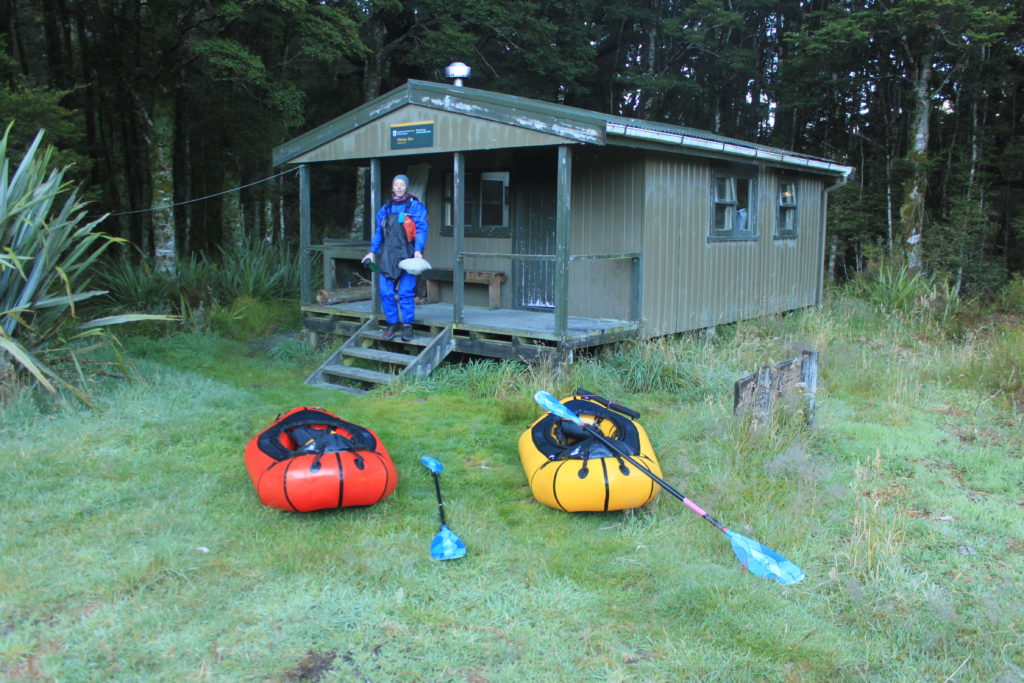
Immediately downstream of the Olivine confluence, there is usually a gravel beach. From the downstream end of the beach, search for a very obvious informal track, where you can carry your boats up to the track and easily onwards to the hut.
Day 5: Olivine Hut to Alabaster Hut 4hrs
The paddle down the middle Pyke is much the same as the Hollyford. Some small class I-II rapids, lots of trees and lots of floating.
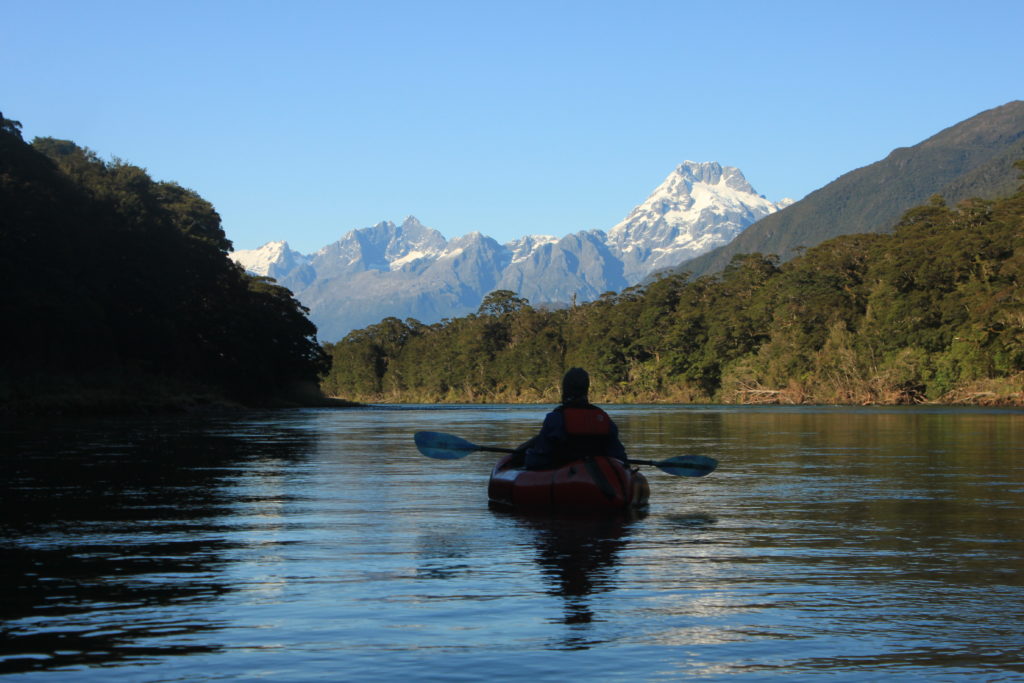
Lake Alabaster isn’t as big as McKerrow, but you wouldn’t want to be out there in significant wind. The prevailing sea breeze is likely to be at your back though.

Lake Alabaster Hut (26 bunks, serviced, heating) can just be seen from the lake, though there aren’t any signs at the lake edge. It’s behind a reasonably obvious gravel beach at the southern end of the Lake.
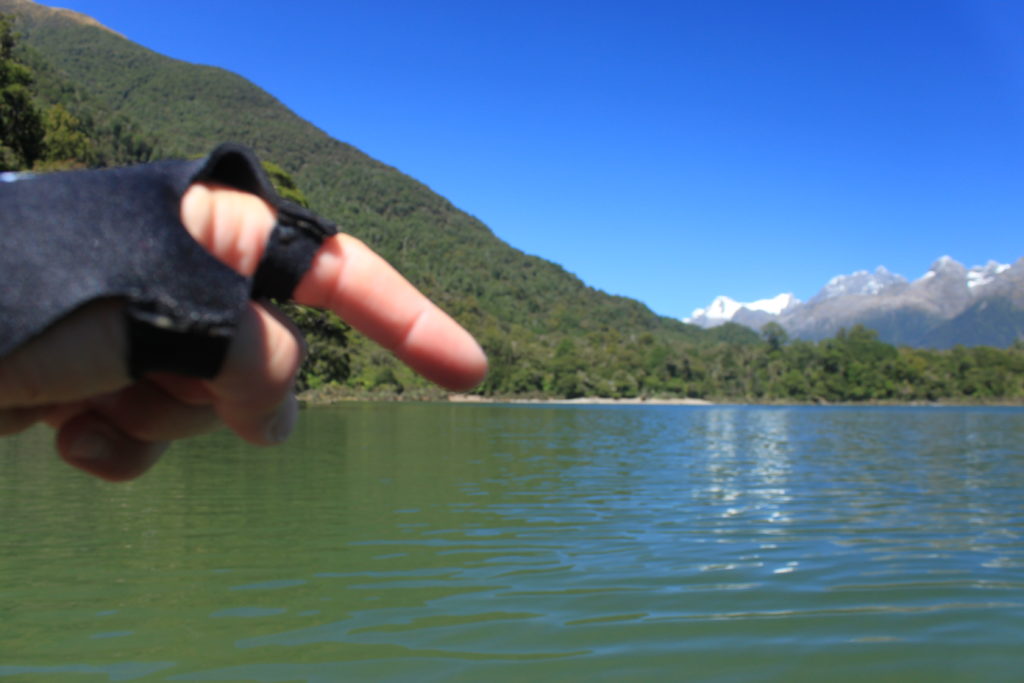
If you are planning to head on to Hidden Falls Hut today, then you can continue paddling downriver. There are a few takeouts along the way, but the most obvious is just downstream of Pyke lodge. The further you go downstream, the higher the chance of missing a takeout and having to do a bit of bush bashing to find the Hollyford track.
If you’re stopping at Alabaster Hut for the night (It’s a great spot!) Then it’s probably better to use the afternoon/evening to dry and sort the paddling gear so your pack is a little lighter and nicely packed ;0)
Day 6: Alabaster Hut to Road end 5.5hrs
- 3.5hrs Alabaster Hut to Hidden Falls Hut
- 2hrs Hidden Falls Hut to Road end
The Hollyford Track is a very well-graded highway compared to the other walking so far. It’s almost a ‘clean boot’ walk to Hidden Falls Hut, via Little Homer Saddle. From Hidden Falls (worth the short detour) it’s another 2 hours or so to the road end.
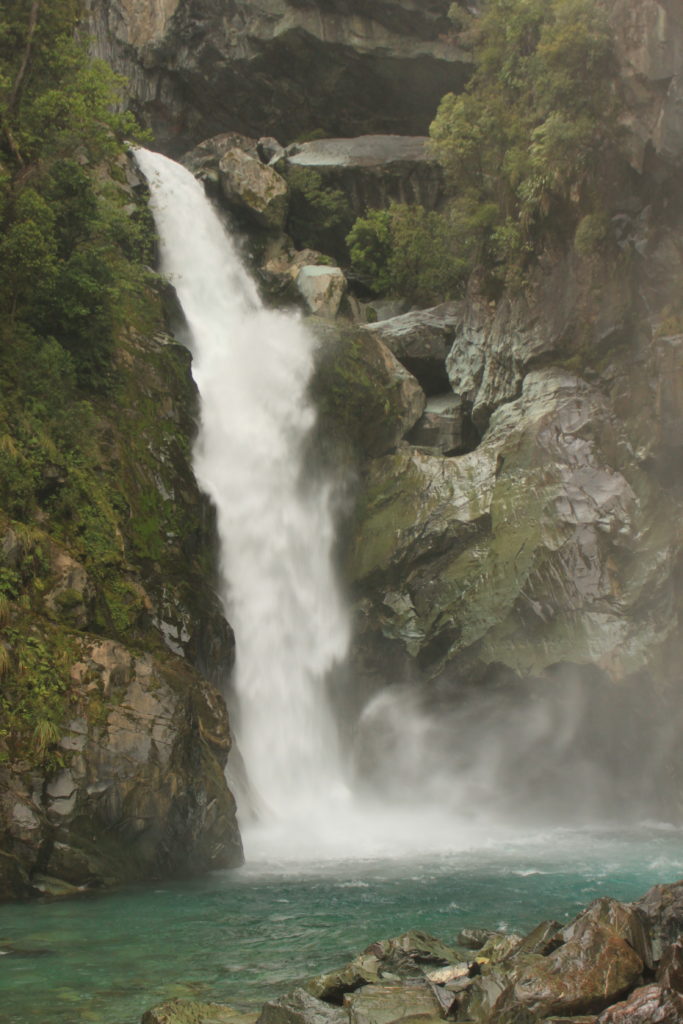
Gauge
Visual.
As we’ve said plenty of times, there are epic floods in these valleys, so make sure you’ve got a non-epic forecast before heading out!
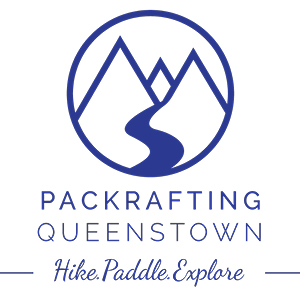

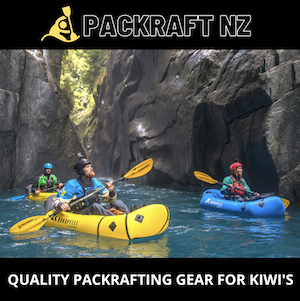

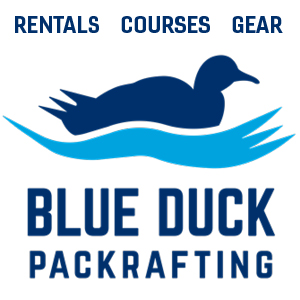


We did the first leg to Mckerrow on a cold crisp sunny day in May. Recent snow fall on hills and some melt possibly boosted flow. Portage 2 log jams early on. We thought we were game for the grade 3+ until we saw it! It was charging and the top section had no obvious line and if you swam you might end up going down the second drop. Bush portage was also quite hard tho.
Great views of Madeline and Tutoko.
1km from the hut is a Perfect 10m long surfing wave formed by a submerged log. 10 mins of effortless surfing.
Gauge upstream of hut read 1.15m
No one else on the water or the track and no jet boats seen despite 6 trailers at the car park.
3.5 hrs back to Pyke confluence then 3.5 hrs to Hidden Falls hut. 2.5 hrs back to car.
Post Feb 2020 flood conditions:
https://packraftingnz.com/update-post-floods-of-the-hollyford-pyke-loop/
Hi there,
I was hoping to aim for this trip 2020. Juat wondering what month you guys usally do this, how much it costs. I would like to start planning for me and a few friends if possible. Im from nz but living in Aus now, done a few hikes and kayak yrips around fiordland but mu friends will be inexperienced. Its is something to train for 🙂
Thank you,
Courtney